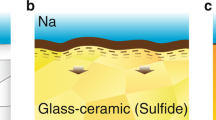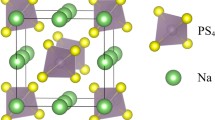Abstract
\({\hbox {Na}}_{2}\hbox {O} {-} {\hbox {B}}_{2} {\hbox {O}}_{3}{-} {\hbox {SiO}}_{2}{-} {\hbox {H}}_{2} {\hbox {O}}\) system hydrated glass with \(T_{\mathrm {g}}\) ranges from \(-10 \hbox { to } 150^{\circ }\)C is synthesized by aqueous chemical methods and is applied to symmetrical cells as quasi-solid electrolyte. At the temperature around \(T_{\mathrm {g}}\), the solid state transforms to quasi-solid state, whose mechanical property keeps like gel electrolyte, but the conductivity leaps from \(5.31 \times 10^{-6} \, {\hbox {S cm}}^{-1}\) to \(5.43 \times 10^{-3} \, {\hbox {S cm}}^{-1}\), much higher than most of the glass–ceramic electrolytes. As most of the solvated water is evaporated, \({\hbox {H}}_{2}{\hbox {O}}\) left in the system distributes in the intervals as hydroxyl, which is much benefit to the ions transportation, and more important is to increase the voltage window to 2.24 V and even higher. The cycle performance is also researched. After 1000 circulations, there is still 65% capacity retention and no obvious damage is discovered in the electrolyte, which means much better cycle property of the electrolyte than gel electrolyte. Other compositions in the quasi-solid system including different contents of \({\hbox {B}}_{2}{\hbox {O}}_{3}\), \({\hbox {Na}}_{2} {\hbox {SO}}_{4}\) and m in sodium silicate \({\hbox {NaO}}_{2}{\cdot }{\hbox {mSiO}}_{2}\) are also studied. In general, quasi-solid \({\hbox {Na}}_{2}\hbox {O} {-} {\hbox {B}}_{2}{\hbox {O}}_{3}{-} {\hbox {SiO}}_{2}{-} {\hbox {H}}_{2}{\hbox {O}}\) system owns better conductivity and cycle performance than most glass–ceramic solid electrolyte, and it is environment-friendly, inexpensive and practical to be used as sodium ions quasi-solid electrolyte.






Similar content being viewed by others
References
Tarascon J M 2010 Philos. Trans. R Soc A 368 3227
Palomares V, Serras P, Villaluenga I, Hueso K B, Carretero-Gonzalez J and Rojo T 2012 Energy Environ. Sci. 5 5884
Goodenough J B and Kim Y 2009 Chem. Mater. 22 587
Colin W, Robert A H and Yi C 2011 J. Power Sources 196 2884
Wenru H, Xianwei G, Xuyang S, Khali A, Haijun Y and Jun L 2018 Nano Energy 52 279
Braga M H, Grundish N S, Murchisona A J and Goodenough J B 2017 Energy Environ. Sci. 10 331
Ivan F 1991 Silica glass and its application (Amsterdam: Elsevier)
Kawaguchi Y 1996 Phys. Rev. B 54 9721
Maryna P P 1989 Glasstech. Ber. 62 249
Karthikeyan A, Vinatier P and Levasseur A 2000 Bull. Mater. Sci. 23 179
Acknowledgements
This work was supported by National Natural Science Foundation of China (51872258).
Author information
Authors and Affiliations
Corresponding author
Rights and permissions
About this article
Cite this article
Zhao, Y., Tong, F., Fan, C. et al. Quasi-solid sodium ions electrolyte of \({\hbox {Na}}_{2} \hbox {O}{-} {\hbox {B}}_{2} {\hbox {O}}_{3}{-} {\hbox {SiO}}_{2} {-} {\hbox {H}}_{2} \hbox {O}\) system hydrated glass. Bull Mater Sci 43, 75 (2020). https://doi.org/10.1007/s12034-020-2050-7
Received:
Accepted:
Published:
DOI: https://doi.org/10.1007/s12034-020-2050-7




